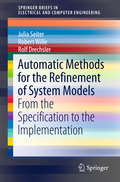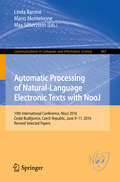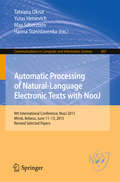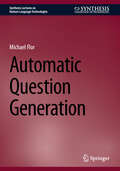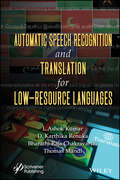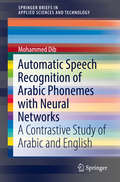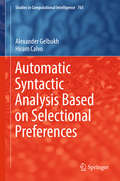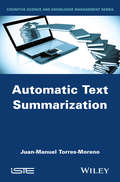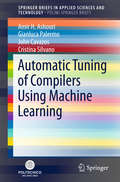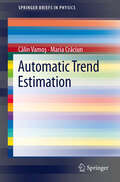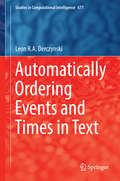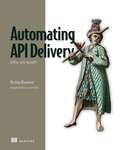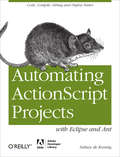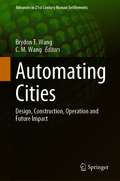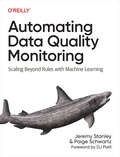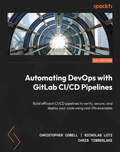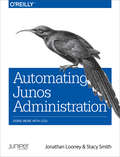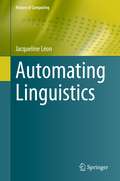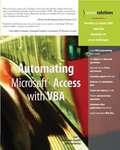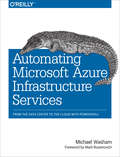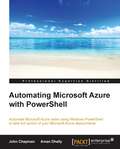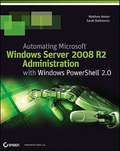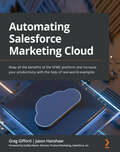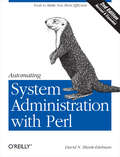- Table View
- List View
Automatic Methods for the Refinement of System Models: From the Specification to the Implementation (SpringerBriefs in Electrical and Computer Engineering)
by Julia Seiter Robert Wille Rolf DrechslerThis book provides a comprehensive overview of automatic model refinement, which helps readers close the gap between initial textual specification and its desired implementation. The authors enable readers to follow two "directions" for refinement: Vertical refinement, for adding detail and precision to single description for a given model and Horizontal refinement, which considers several views on one level of abstraction, refining the system specification by dedicated descriptions for structure or behavior. The discussion includes several methods which support designers of electronic systems in this refinement process, including verification methods to check automatically whether a refinement has been conducted as intended.
Automatic Processing of Natural-Language Electronic Texts with NooJ: 10th International Conference, NooJ 2016, České Budějovice, Czech Republic, June 9-11, 2016, Revised Selected Papers (Communications in Computer and Information Science #667)
by Max Silberztein Linda Barone Mario MonteleoneThis book constitutes the refereed proceedings of the 9th International Conference, NooJ 2015, held in Minsk, Belarus, in June 2015. NooJ 2015 received 51 submissions. The 20 revised full papers presented in this volume were carefully reviewed and selected from the 35 papers that were presented at the conference. The papers are organized in topical sections on corpora, vocabulary and morphology; syntax and semantics; application.
Automatic Processing of Natural-Language Electronic Texts with NooJ: 9th International Conference, NooJ 2015, Minsk, Belarus, June 11-13, 2015, Revised Selected Papers (Communications in Computer and Information Science #607)
by Max Silberztein Tatsiana Okrut Yuras Hetsevich Hanna StanislavenkaThis book constitutes the refereed proceedings of the 9th International Conference, NooJ 2015, held in Minsk, Belarus, in June 2015. NooJ 2015 received 51 submissions. The 20 revised full papers presented in this volume were carefully reviewed and selected from the 35 papers that were presented at the conference. The papers are organized in topical sections on corpora, vocabulary and morphology; syntax and semantics; application.
Automatic Question Generation (Synthesis Lectures on Human Language Technologies)
by Michael FlorThis book provides an overview of the fundamentals of Automatic Question Generation (AQG) for computational linguistics researchers, test developers, and educators. The author presents a variety of AQG system architectures, including generating questions from syntactic analyses, semantic resources, neural architectures, ontologies and knowledge graphs, and large language models. The advantages and pitfalls of a variety of AQG evaluation methods, including multi-aspect ratings by human experts, end-users, as well as crowd-sourcing and automatic evaluation techniques are discussed. The book also provides a roadmap of options for AQG targeted orientation, content selection, and focusing decisions. Machine learning opportunities for training systems to generate questions based on human-generated examples are also explored. This book offers greater depth and breadth than previous surveys of AQG. Readers will gain a comprehensive knowledge of current research, examples of applications of AQG, and inspiration for future directions for innovation and application.
Automatic Speech Recognition and Translation for Low Resource Languages
by L. Ashok Kumar Thomas Mandl D. Karthika Renuka Bharathi Raja ChakravarthiAUTOMATIC SPEECH RECOGNITION and TRANSLATION for LOW-RESOURCE LANGUAGES This book is a comprehensive exploration into the cutting-edge research, methodologies, and advancements in addressing the unique challenges associated with ASR and translation for low-resource languages. Automatic Speech Recognition and Translation for Low Resource Languages contains groundbreaking research from experts and researchers sharing innovative solutions that address language challenges in low-resource environments. The book begins by delving into the fundamental concepts of ASR and translation, providing readers with a solid foundation for understanding the subsequent chapters. It then explores the intricacies of low-resource languages, analyzing the factors that contribute to their challenges and the significance of developing tailored solutions to overcome them. The chapters encompass a wide range of topics, ranging from both the theoretical and practical aspects of ASR and translation for low-resource languages. The book discusses data augmentation techniques, transfer learning, and multilingual training approaches that leverage the power of existing linguistic resources to improve accuracy and performance. Additionally, it investigates the possibilities offered by unsupervised and semi-supervised learning, as well as the benefits of active learning and crowdsourcing in enriching the training data. Throughout the book, emphasis is placed on the importance of considering the cultural and linguistic context of low-resource languages, recognizing the unique nuances and intricacies that influence accurate ASR and translation. Furthermore, the book explores the potential impact of these technologies in various domains, such as healthcare, education, and commerce, empowering individuals and communities by breaking down language barriers. Audience The book targets researchers and professionals in the fields of natural language processing, computational linguistics, and speech technology. It will also be of interest to engineers, linguists, and individuals in industries and organizations working on cross-lingual communication, accessibility, and global connectivity.
Automatic Speech Recognition of Arabic Phonemes with Neural Networks: A Contrastive Study of Arabic and English (SpringerBriefs in Applied Sciences and Technology)
by Mohammed DibThis book presents a contrastive linguistics study of Arabic and English for the dual purposes of improved language teaching and speech processing of Arabic via spectral analysis and neural networks. Contrastive linguistics is a field of linguistics which aims to compare the linguistic systems of two or more languages in order to ease the tasks of teaching, learning, and translation. The main focus of the present study is to treat the Arabic minimal syllable automatically to facilitate automatic speech processing in Arabic. It represents important reading for language learners and for linguists with an interest in Arabic and computational approaches.
Automatic Syntactic Analysis Based on Selectional Preferences (Studies In Computational Intelligence #765)
by Alexander Gelbukh Hiram CalvoThis book describes effective methods for automatically analyzing a sentence, based on the syntactic and semantic characteristics of the elements that form it. To tackle ambiguities, the authors use selectional preferences (SP), which measure how well two words fit together semantically in a sentence. Today, many disciplines require automatic text analysis based on the syntactic and semantic characteristics of language and as such several techniques for parsing sentences have been proposed. Which is better? In this book the authors begin with simple heuristics before moving on to more complex methods that identify nouns and verbs and then aggregate modifiers, and lastly discuss methods that can handle complex subordinate and relative clauses. During this process, several ambiguities arise. SP are commonly determined on the basis of the association between a pair of words. However, in many cases, SP depend on more words. For example, something (such as grass) may be edible, depending on who is eating it (a cow?). Moreover, things such as popcorn are usually eaten at the movies, and not in a restaurant. The authors deal with these phenomena from different points of view.
Automatic Text Summarization
by Juan Manuel Torres MorenoTextual information in the form of digital documents quickly accumulates to create huge amounts of data. The majority of these documents are unstructured: it is unrestricted text and has not been organized into traditional databases. Processing documents is therefore a perfunctory task, mostly due to a lack of standards. It has thus become extremely difficult to implement automatic text analysis tasks. Automatic Text Summarization (ATS), by condensing the text while maintaining relevant information, can help to process this ever-increasing, difficult-to-handle, mass of information.This book examines the motivations and different algorithms for ATS. The author presents the recent state of the art before describing the main problems of ATS, as well as the difficulties and solutions provided by the community. The book provides recent advances in ATS, as well as current applications and trends. The approaches are statistical, linguistic and symbolic. Several examples are also included in order to clarify the theoretical concepts.
Automatic Tuning of Compilers Using Machine Learning (SpringerBriefs in Applied Sciences and Technology)
by Cristina Silvano Gianluca Palermo John Cavazos Amir H. AshouriThis book explores break-through approaches to tackling and mitigating the well-known problems of compiler optimization using design space exploration and machine learning techniques. It demonstrates that not all the optimization passes are suitable for use within an optimization sequence and that, in fact, many of the available passes tend to counteract one another. After providing a comprehensive survey of currently available methodologies, including many experimental comparisons with state-of-the-art compiler frameworks, the book describes new approaches to solving the problem of selecting the best compiler optimizations and the phase-ordering problem, allowing readers to overcome the enormous complexity of choosing the right order of optimizations for each code segment in an application. As such, the book offers a valuable resource for a broad readership, including researchers interested in Computer Architecture, Electronic Design Automation and Machine Learning, as well as computer architects and compiler developers.
Automatic trend estimation (SpringerBriefs in Physics)
by Maria Cr˘aciun C˘alin Vamos¸Our book introduces a method to evaluate the accuracy of trend estimation algorithms under conditions similar to those encountered in real time series processing. This method is based on Monte Carlo experiments with artificial time series numerically generated by an original algorithm. The second part of the book contains several automatic algorithms for trend estimation and time series partitioning. The source codes of the computer programs implementing these original automatic algorithms are given in the appendix and will be freely available on the web. The book contains clear statement of the conditions and the approximations under which the algorithms work, as well as the proper interpretation of their results. We illustrate the functioning of the analyzed algorithms by processing time series from astrophysics, finance, biophysics, and paleoclimatology. The numerical experiment method extensively used in our book is already in common use in computational and statistical physics.
Automatically Ordering Events and Times in Text (Studies in Computational Intelligence #677)
by Leon R.A. DerczynskiThe book offers a detailed guide to temporal ordering, exploring open problems in the field and providing solutions and extensive analysis. It addresses the challenge of automatically ordering events and times in text. Aided by TimeML, it also describes and presents concepts relating to time in easy-to-compute terms. Working out the order that events and times happen has proven difficult for computers, since the language used to discuss time can be vague and complex. Mapping out these concepts for a computational system, which does not have its own inherent idea of time, is, unsurprisingly, tough. Solving this problem enables powerful systems that can plan, reason about events, and construct stories of their own accord, as well as understand the complex narratives that humans express and comprehend so naturally. This book presents a theory and data-driven analysis of temporal ordering, leading to the identification of exactly what is difficult about the task. It then proposes and evaluates machine-learning solutions for the major difficulties. It is a valuable resource for those working in machine learning for natural language processing as well as anyone studying time in language, or involved in annotating the structure of time in documents.
Automating API Delivery: APIOps with OpenAPI
by Ikenna NwaiwuImprove speed, quality, AND cost by automating your API delivery process!Automating API Delivery shows you how to strike the perfect balance between speed and usability by applying DevOps automation principles to your API design and delivery process. It lays out a clear path to making both the organizational and technical changes you need to deliver high-quality APIs both rapidly and reliably. In Automating API Delivery you&’ll learn how to: Enforce API design standards with linting Automate breaking-change checks to control design creep Ensure accuracy of API reference documents Centralize API definition consistency checks Automate API configuration deployment Conduct effective API design reviews Author Ikenna Nwaiwu provides comprehensive guidance on implementing APIOps in your organization. He carefully walks through the technical steps and introduces the essential open-source tools, with practical advice and insights from his years of experience. You&’ll benefit from his personal tips for avoiding common pitfalls and challenges of moving to automated API delivery. Foreword by Melissa van der Hecht. About the technology Create high quality, consistent, and fast-to-market APIs by automating the development process! This innovative book shows you how to apply established Continuous Delivery and DevOps principles along the whole API lifecycle, transforming a collection of individual tasks into a smooth, manageable pipeline that supports automated testing, iterative improvement, and reliable documentation. About the book Automating API Delivery introduces the tools and strategies behind APIOps. You&’ll discover tools and process improvements that give you important quick wins, including API governance using the Spectral API linter and establishing an efficient CI/CD pipeline with GitHub Actions. You&’ll even discover how to use the powerful OpenAPI Generator to automatically create client and server code from your API definitions. What's inside Check for breaking changes with oasdiff Create SDKs using OpenAPI Generator Maintain accurate documentation with API conformance tests Deploy API gateway configuration with GitOps About the reader Experience building RESTful APIs required. About the author Ikenna Nwaiwu is Principal Consultant at Ikenna Consulting, specializing in automating API governance. The technical editor on this book was Marjukka Niinioja. Table of Contents 1 What is APIOps? 2 Leaning into APIOps: Problem-solving and leading improvements 3 API linting: Automating API consistency 4 Breaking change checks: Managing API evolution 5 API design review: Checking for what you cannot automate 6 API conformance: Generating code and API definitions 7 API conformance: Schema testing 8 CI/CD for API artifacts 1: Source-stage governance controls 9 CI/CD for API artifacts 2: Build-stage and API configuration deployment 10 More on API consistency: Custom linting and security checks 11 Monitoring and analytics: Measuring API product metrics Appendixes A Value stream mapping icons B Installing API linting and OpenAPI diff tools C Introduction to JSON Pointer D Tools for API conformance and analytics E Docker and Kubernetes
Automating ActionScript Projects with Eclipse and Ant
by Sidney De KoningAutomating repetitive programming tasks is easier than many Flash/AS3 developers think. With the Ant build tool, the Eclipse IDE, and this concise guide, you can set up your own "ultimate development machine" to code, compile, debug, and deploy projects faster. You'll also get started with versioning systems, such as Subversion and Git. Create a consistent workflow for multiple machines, or even complete departments, with the help of extensive Ant code samples. If you want to work smarter and take your skills to a new level, this book will get you on the road to automation--with Ant. Set up your Eclipse work environment with Eclipse plugins, including the FDT code editor and the Mylyn task manager Enable several developers to work on the same project simultaneously with a versioning system Walk through the basics of Ant, and use sample code to create your first script Compile and debug your Ant build with FDT or the Flex SDK Apply Ant to mobile development for both the Android Platform and iOS, using the Android SDK and Adobe Air
Automating ActionScript Projects with Eclipse and Ant: Code, Compile, Debug and Deploy Faster
by Sidney De KoningAutomating repetitive programming tasks is easier than many Flash/AS3 developers think. With the Ant build tool, the Eclipse IDE, and this concise guide, you can set up your own "ultimate development machine" to code, compile, debug, and deploy projects faster. You’ll also get started with versioning systems, such as Subversion and Git.Create a consistent workflow for multiple machines, or even complete departments, with the help of extensive Ant code samples. If you want to work smarter and take your skills to a new level, this book will get you on the road to automation—with Ant.Set up your Eclipse work environment with Eclipse plugins, including the FDT code editor and the Mylyn task managerEnable several developers to work on the same project simultaneously with a versioning systemWalk through the basics of Ant, and use sample code to create your first scriptCompile and debug your Ant build with FDT or the Flex SDKApply Ant to mobile development for both the Android Platform and iOS, using the Android SDK and Adobe Air
Automating Cities: Design, Construction, Operation and Future Impact (Advances in 21st Century Human Settlements)
by C. M. Wang Brydon T. WangThis book highlights the latest advancements in the use of automated systems in the design, construction, operation and future of the built environment and its occupants. It considers how the use of automated decision-making frameworks, artificial intelligence and other technologies of automation are presently impacting the practice of architects, engineers, project managers and contractors, and articulates the near future changes to workflows, legal frameworks and the wider AEC industry. This book surveys and compiles the use of city apps, robots that operate buildings and fabricate structural elements, 3D printing, drones, sensors, algorithms, and advanced prefabricated modules. The book also contributes to the growing literature on smart cities, and explores the impacts on data privacy and data sovereignty that arise through the use of sensors, digital twins and intelligent transport systems. It provides a useful reference for further research and development in the area of automation in design and construction to architects, engineers, project managers, superintendents and construction lawyers, contractors, policy makers, and students.
Automating Data Quality Monitoring: Scaling Beyond Rules with Machine Learning
by Jeremy Stanley Paige SchwartzThe world's businesses ingest a combined 2.5 quintillion bytes of data every day. But how much of this vast amount of data--used to build products, power AI systems, and drive business decisions--is poor quality or just plain bad? This practical book shows you how to ensure that the data your organization relies on contains only high-quality records.Most data engineers, data analysts, and data scientists genuinely care about data quality, but they often don't have the time, resources, or understanding to create a data quality monitoring solution that succeeds at scale. In this book, Jeremy Stanley and Paige Schwartz from Anomalo explain how you can use automated data quality monitoring to cover all your tables efficiently, proactively alert on every category of issue, and resolve problems immediately.This book will help you:Learn why data quality is a business imperativeUnderstand and assess unsupervised learning models for detecting data issuesImplement notifications that reduce alert fatigue and let you triage and resolve issues quicklyIntegrate automated data quality monitoring with data catalogs, orchestration layers, and BI and ML systemsUnderstand the limits of automated data quality monitoring and how to overcome themLearn how to deploy and manage your monitoring solution at scaleMaintain automated data quality monitoring for the long term
Automating DevOps with GitLab CI/CD Pipelines: Build efficient CI/CD pipelines to verify, secure, and deploy your code using real-life examples
by Christopher Cowell Nicholas Lotz Chris TimberlakeUse GitLab CI/CD pipelines for automating and deploying different steps of your software development lifecycle using best practices and troubleshooting methods.Key FeaturesReap the power of GitLab CI/CD pipelines at every stage of your software development lifecycleLearn how GitLab makes Git easier to use and more powerful when committing and reviewing codeCement your understanding using hands-on tutorials and extensive self-assessment exercisesPurchase of the print or Kindle book includes a free eBook in the PDF formatBook DescriptionDevelopers and release engineers understand the high stakes involved in building, packaging, and deploying code correctly. Ensuring that your code is functionally correct, fast, and secure is a time-consuming and complex task. Code implementation, development, and deployment can be conducted efficiently using GitLab CI/CD pipelines.Automating DevOps with GitLab CI/CD Pipelines begins with the basics of Git and GitLab, showing how to commit and review code. You'll learn to set up GitLab Runners for executing and autoscaling CI/CD pipelines and creating and configuring pipelines for many software development lifecycle steps. You'll also discover where to find pipeline results in GitLab, and how to interpret those results. Through the course of the book, you'll become well-equipped with deploying code to different environments, advancing CI/CD pipeline features such as connecting GitLab to a Kubernetes cluster and using GitLab with Terraform, triggering pipelines and improving pipeline performance and using best practices and troubleshooting tips for uncooperative pipelines. In-text examples, use cases, and self-assessments will reinforce the important CI/CD, GitLab, and Git concepts, and help you prepare for interviews and certification exams related to GitLab.By the end of this book, you'll be able to use GitLab to build CI/CD pipelines that automate all the DevOps steps needed to build and deploy high-quality, secure code.What you will learnGain insights into the essentials of Git, GitLab, and DevOpsUnderstand how to create, view, and run GitLab CI/CD pipelinesExplore how to verify, secure, and deploy code with GitLab CI/CD pipelinesConfigure and use GitLab Runners to execute CI/CD pipelinesExplore advanced GitLab CI/CD pipeline features like DAGs and conditional logicFollow best practices and troubleshooting methods of GitLab CI/CD pipelinesImplement end-to-end software development lifecycle workflows using examplesWho this book is forThis book is for DevOps/DevSecOps engineers, application developers, release engineers, quality assurance engineers, security engineers, SREs, and sysadmins looking to implement fast, secure and automated software development lifecycle tasks using continuous integration and continuous delivery (CI/CD) pipelines in GitLab. Basic knowledge of major stages of the software development life cycle and DevOps processes will be helpful.
Automating Junos Administration: Doing More with Less
by Stacy Smith Jonathan LooneyHow can you grow and maintain a reliable, flexible, and cost-efficient network in the face of ever-increasing demands? With this practical guide, network engineers will learn how to program Juniper network devices to perform day-to-day tasks, using the automation features of the Junos OS.Junos supports several automation tools that provide powerful solutions to common network automation tasks. Authors Jonathan Looney and Stacy Smith, senior testing engineers at Juniper, will help you determine which tools work best for your particular network requirements. If you have experience with Junos, this book will show you how automation can make a big difference in the operation of your existing network.Manage Junos software with remote procedure calls and a RESTful APIRepresent devices as Python objects and manage them with Python’s PyEZ packageCustomize Junos software to detect and block commits that violate your network standardsDevelop custom CLI commands to present information the way you wantProgram Junos software to automatically respond to network eventsRapidly deploy new Junos devices into your network with ZTP and Netconify toolsLearn how to use Ansible or Puppet to manage Junos software
Automating Linguistics (History of Computing)
by Jacqueline LéonAutomating Linguistics offers an in-depth study of the history of the mathematisation and automation of the sciences of language. In the wake of the first mathematisation of the 1930s, two waves followed: machine translation in the 1950s and the development of computational linguistics and natural language processing in the 1960s. These waves were pivotal given the work of large computerised corpora in the 1990s and the unprecedented technological development of computers and software.Early machine translation was devised as a war technology originating in the sciences of war, amidst the amalgamate of mathematics, physics, logics, neurosciences, acoustics, and emerging sciences such as cybernetics and information theory. Machine translation was intended to provide mass translations for strategic purposes during the Cold War. Linguistics, in turn, did not belong to the sciences of war, and played a minor role in the pioneering projects of machine translation.Comparing the two trends, the present book reveals how the sciences of language gradually integrated the technologies of computing and software, resulting in the second-wave mathematisation of the study of language, which may be called mathematisation-automation. The integration took on various shapes contingent upon cultural and linguistic traditions (USA, ex-USSR, Great Britain and France). By contrast, working with large corpora in the 1990s, though enabled by unprecedented development of computing and software, was primarily a continuation of traditional approaches in the sciences of language sciences, such as the study of spoken and written texts, lexicography, and statistical studies of vocabulary.
Automating Microsoft Access with VBA
by Mike Gunderloy Susan Sales HarkinsProgramming Microsoft Access using the Visual Basic for Applications (VBA) language.
Automating Microsoft Azure Infrastructure Services: From the Data Center to the Cloud with PowerShell
by Michael WashamGet valuable tips and techniques for automating your cloud deployments with Azure PowerShell cmdlets, and learn how to provision Azure services on the fly. In this hands-on guide, Microsoft cloud technology expert Michael Washam shows you how to automate various management tasks and deploy solutions that are both complex and at scale.By combining the native automation capabilities of PowerShell with Azure Infrastructure Services, these powerful cmdlets enable you to create and configure virtual machines with ease. You’ll learn how to take advantage of these technologies to build complete virtual networks. If you have experience with PowerShell and Azure, you’re ready to get started.Install and authenticate cmdlets to set up your environmentCreate and update virtual machines with Azure platform imagesManage network endpoints, access control lists, and IP addressesUse cmdlets to manage and configure virtual machine storageAutomate Azure virtual networks with hybrid technologies such as site-to-site, point-to-site, and ExpressRouteDive into advanced virtual machine provisioning capabilities and management techniquesLearn tips and tricks for deleting or moving virtual machines within (or out of) your subscription
Automating Microsoft Azure with PowerShell
by John Chapman Aman DhallyThis book is designed to help administrators and developers better automate Azure management tasks. No prior knowledge of PowerShell is required.
Automating Microsoft Windows Server 2008 R2 with Windows PowerShell 2.0
by Matthew Hester Sarah DutkiewiczLearn to automate the top server operating system, Windows Server 2008 R2 Windows PowerShell 2. 0 allows you to automate nearly any task for managing Windows Server, going from dozens of clicks to a single command, and repeated tasks to automated tasks. Using screen shots and helpful exercises, this book walks you through the many benefits of automating Windows Server with PowerShell 2. 0, such as allowing for scalable, flexible, and rapid deployments and changes; increasing cost effectiveness; providing a timely return on IT investment; lowering labor headcount; creating secure computing environments; and establishing reliable enterprise infrastructures. In addition, real-world examples provide reinforced learning, aimed at ensuring that you work as efficiently and effectively as possible by automating both simple and complex administrative tasks with Powershell 2. 0. Explains how to automate both simple and complex tasks in Windows Server 2008 R2 with Powershell 2. 0 Addresses how Windows Server 2008 R2 comes with more than 550 cmdlets, allowing you to automate nearly anything Offers numerous real-world examples, end-of-chapter exercises, and helpful screen shots to reinforce your learning process The power is in your hands! Start working smarter, not harder, by automating Windows Server 2008 R2 tasks with Powershell 2. 0.
Automating Salesforce Marketing Cloud: Reap all the benefits of the SFMC platform and increase your productivity with the help of real-world examples
by Greg Gifford Jason Hanshaw Guilda HilaireMake the most of Salesforce Marketing Cloud through automation and increase your productivity on the platform without adding any extra resourcesKey FeaturesIncrease your knowledge of automation theory and the applications of SFMCExplore automation with SFMC and its capabilities beyond general usageUnderstand the automation features and integrations of SFMC to use the platform from outside the user interface (UI) for maximum efficiencyBook DescriptionSalesforce Marketing Cloud (SFMC) allows you to use multiple channels and tools to create a 1:1 marketing experience for your customers and subscribers. Through automation and helper tasks, you can greatly increase your productivity while also reducing the level of effort required in terms of volume and frequency. Automating Salesforce Marketing Cloud starts by discussing what automation is generally and then progresses to what automation is in SFMC. After that, you'll focus on how to perform automation inside of SFMC all the way to fully running processes and capabilities from an external service. Later chapters explore the benefits and capabilities of automation and having an automation mindset both within and outside of SFMC. Equipped with this knowledge and example code, you'll be prepared to maximize your SFMC efficiency. By the end of this Salesforce book, you'll have the skills you need to build automation both inside and outside of SFMC, along with the knowledge for using the platform optimally.What you will learnUnderstand automation to make the most of the SFMC platformOptimize ETL activities, data import integrations, data segmentations, email sends, and moreExplore different ways to use scripting and API calls to increase Automation Studio efficiencyIdentify opportunities for automation with custom integrations and third-party solutionsOptimize usage of SFMC by building on the core concepts of custom integrations and third-party toolsMaximize utilization of employee skills and capabilities and reduce operational costs while increasing outputWho this book is forThis book is for Salesforce Marketing Cloud users who want to know how to make their day to day lives more efficient and get the most out of the tool by working smarter, not harder. A solid understanding of SFMC and basic knowledge of what automation is will help you get the most out of this book.
Automating System Administration with Perl: Tools to Make You More Efficient
by David N. Blank-EdelmanIf you do systems administration work of any kind, you have to deal with the growing complexity of your environment and increasing demands on your time. Automating System Administration with Perl, Second Edition, not only offers you the right tools for your job, but also suggests the best way to approach specific problems and to securely automate recurring tasks.Updated and expanded to cover the latest operating systems, technologies, and Perl modules, this edition of the "Otter Book" will help you:Manage user accountsMonitor filesystems and processesWork with configuration files in important formats such as XML and YAMLAdminister databases, including MySQL, MS-SQL, and Oracle with DBIWork with directory services like LDAP and Active DirectoryScript email protocols and spam controlEffectively create, handle, and analyze log filesAdminister network name and configuration services, including NIS, DNS and DHCPMaintain, monitor, and map network services, using technologies and tools such as SNMP, nmap, libpcap, GraphViz and RRDtoolImprove filesystem, process, and network securityThis edition includes additional appendixes to get you up to speed on technologies such as XML/XPath, LDAP, SNMP, and SQL. With this book in hand and Perl in your toolbox, you can do more with less -- fewer resources, less effort, and far less hassle.
